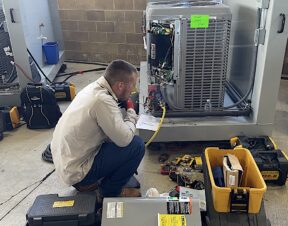Following the footsteps of Frederick Law Olmstead, I try, every day, to immerse myself into green spaces. Considered the “father” of American landscape architecture, and known for his critical thinking in urban planning and design, Olmstead—of Central Park fame—encouraged the full utilization of the naturally occurring features of a given natural space. To Olmstead, a park, for example, is a necessity of everyday urban life, and subjecting oneself to it—once a day, at the very least, he believed—is essential to a healthier life.

Nationally, if wind energy continues to grow to be 35% by 2050, says the Illinois State University report, we can expect that there will be a 2% savings in electric rates for consumers, and a 3$ savings in power systems costs. Pollution and water use will continue to fall, and 600,000 jobs will be supported across the nation. Yet, will all of these benefits be enough to console the local landowners that have to live near these towers?
My commute, about an hour west of Chicago, provides ample opportunity to experience green space in abundance. Lately, however, my view has been marred by a growing number of “No Wind Turbine” signs spattered across the countryside.
To me, it seems to be a case of trading one farm for another, or at least co-sharing farms, but to others, especially those who have moved from the city to a more peaceful, rural setting, don’t want their pastoral visions marred either; the construction of wind towers might potentially interfere with this dream of a “quieter” life. Beyond aesthetics and noise, there is much concern regarding depreciating home values form residents situated near wind towers.
However, a study released by the Lawrence Berkeley National Laboratory found little evidence that wind farms depress home values. “Neither the view of the wind farms nor the distance of the home to those facilities is found to have any consistent, measurable and significant effect on home sale prices,” the study concludes. Further, the productivity numbers can’t be denied.
A study, “Economic Impact—Illinois Wind Energy Development,” conducted by the Center for Renewable Energy at Illinois State University, states that as of April 2016, the Land of Lincoln ranked 5th in the U.S. in overall wind capacity, and 14th in potential capacity. Illinois has approximately 46 wind projects online, which will account for 3,842.15 MW of wind-generating capacity. In fact, the 25 largest wind farms in Illinois:
- Create approximately 20,173 full-time jobs during construction periods.
- Support approximately 869 permanent jobs in rural Illinois.
- Support local economies by generating $30.4 million in annual property taxes.
- Generate $13.86 million annually in extra income for Illinois landowners who lease their land to the wind farm developer.
- Will generate a total economic benefit of $6.4 billion over the life of the projects.
Illinois is pushing for more renewable power. The Future Energy Jobs Act has essentially removed wind energy requirements and the legislation could generate $2.2 from new wind construction. The Future Energy Jobs Act will strengthen and expand the Renewable Portfolio Standard to ensure predictable funding for the renewable development, providing $180 million per year—growing to $220 million per year.
These numbers are true. If only Olmstead could weigh in on the need to balance green space with the need for green power.



